한식 읽기 좋은 날
Vol 33. Gwamegi - Gyeongsang
A special taste that comes with winter cold, Gwamegi
Gourmet travel for regional food ingredients
Hansik glossary
Gwamegi - Half-dried saury
It is so disappointed if Gwamegi(half-dried saury) made of saury is missing
among the powers of winter sea gourmet such as oyster,
yellow tail and spotted mackerel.
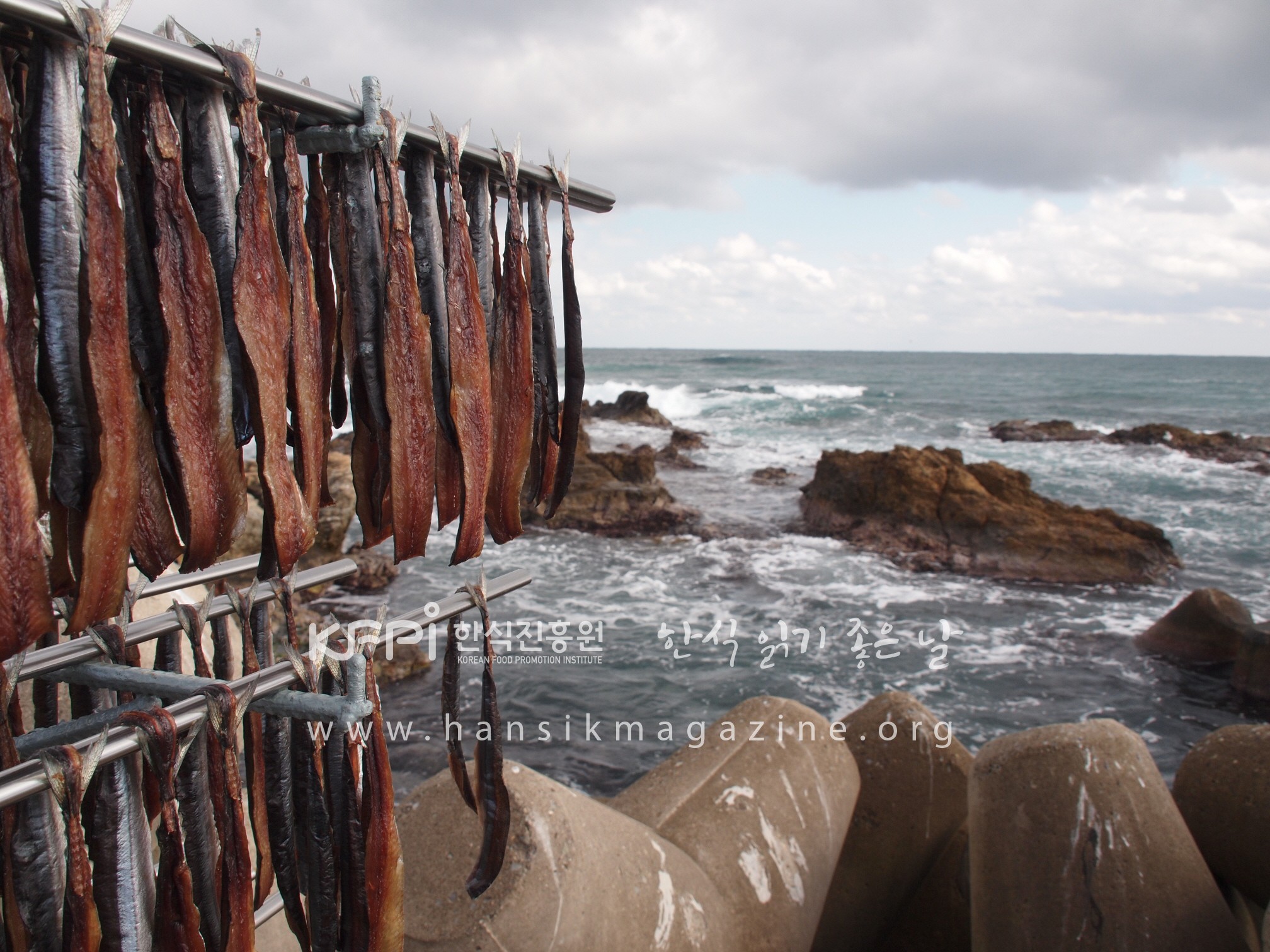
When the chilly wind blows every year, I came to miss gwamegi ⓒ Jeong Chul Young, Pohang City Hall
As the autumn gets shorter, the winter seems to come earlier. When the chilly breeze starts to blow, Changes are coming to our food, clothing, and shelter. The change leads us to raise the boiler temperature, to take out thick clothes and to seek hot stew or soup. Even if there is a difference depending on person, it is rare to want to eat kongguksu(noodles in cold soybean soup), a summer food, in winter.
However, turning your eyes to beach, there are quite a lot of ingredients that must be eaten cold in winter to make them taste good. There are yellow tails that gourmets line up to eat them every winter, and raw spotted mackerel and raw oyster which can be tasted only in chilly winter. And there are also lots of big fans of gwamegi in which the saury considered as ‘cheap fish’ is transformed under the sea wind.
The gwamegi made in the beach of East Sea is a typical winter seasonal food which can be only produced when the chilly breeze starts to blow. While the saury is dried by the wind, the taste and the aroma are deeply permeated, and soon transformed to the plain and sticky gwamegi. There are also the other regions that produce gwamegi, Pohang is the highest in the production and the consumption to the extent it is known as Pohang’s food.
Birth of gwamegi recorded in the literature
Now, gwamegi is mainly made of saury but it is known to be made of herring in the past. Because the herrings were caught commonly, many domestic literatures show the record of drying and salting herring from long ago. Even if it is hard to know it was the form of gwamegi like these days, the history to eat herrings as a preserving food was long as such.
The gwamegi is made of herring even these days, but making it with saury became common. According to Jang Cheonsu, a director of Pohang Excellent Seafood cooperative, "Since around the late of 1960s, the herring catch stopped, they started to be substituted with saury, since the late of 1980, gwamegi made of saury came to be commercialized nationwide." The image of herring and saury may be a little different, it is funny they became the same gwamegi after going through drying process.
If so, it is natural to be curious about the name of gwamegi. There are many different opinions about this. First, the book <Socheonsoji> published in 1918 has the story about a scholar who was on his way to Hanyang for the governmental official test, and he was very hungry, ate the herring with its eyes skewered at beach, then it was so tasty, so he came to eat dried herring every winter afterward. It is estimated that the Chinese character "gwanmok (fish with their eyes skewered)" has changed into the "gwamegi", <Socheonsoji>is a joke value so its historical value is not high.
The literature which commented the origin of gwamegi closely is a book <Gyuhapchongseo> with the contents about housekeeping in 1809. This book has a sentence 'when the herring of which eyes are skewered and see through transparently is dried, the taste is eccentric'. According to this, the fish with transparent head to the extent their eyes in the opposite side see through, which can be discovered 1~2 among 100 herrings, is called Gwanmok, and there is the opinion that this fish is the origin of gwamegi(some people insist Gwanmok is saury). In addition, <Gyuhapchongseo> says the story about Gwamok is smoked by hanging it in the ceiling of kitchen, which is very similar with the traditional way of cooking gwamegi.
Change in production system in the past and modern time
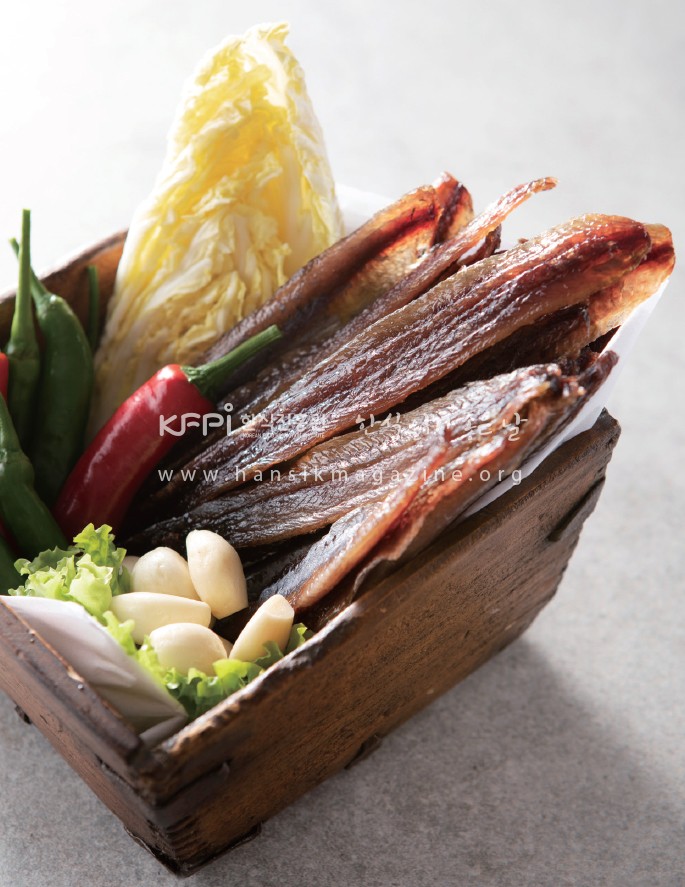
The gwamegi has been enjoyed with various methods along with the nature,
these days when it became famous nationwide,
the mass production is made by the deokjang(production site) which handles professionally.
ⓒ Pohang City Hall
The introduction of gwamegi at Pohang city homepage shows the traditional way of making gwamegi. Skewering the eyes of saury using bush clover or bamboo in winter, hanging it around Bongchang(small hole opened at the top of kitchen) of traditional kitchen, and letting them smoked and dried by naturally leaking smoke. At night, the fire is not used in the kitchen, and the kitchen door is opened to prevent foods from going bad, resulting the saury freeze, and when making a fire to make meal in the morning, the saury thaws, during these repeated process of freezing, thawing and smoking for several days, the gwamegi was made.
These days when gwamegi became famous nationwide, the mass production is made by the deokjang which handles it professionally. The deokjang that purchased mass quantity of saury washes the saury, bundles 10 each, hangs them in a row at the wood column and dries them. Thanks to this, if you go to Guryongpo in Pohang during the winter season, you can easily see the rare scene of saury hanging in a raw from anywhere on the beach. Some people hate the fishy smell carried by the sea wind but it is a time when the tasty gwamegi is made for lovers.
It sounds like funny, but some say that sailors throw fresh saury on the roof to make side dishes and eat the finished gwamegi a few days later. However, it is not that easy to make the gwamegi. Because saury is rich in fat and protein, when the oil may rancidify by the direct sunshine. Because the protein decay occurs even if the temperature does not drop properly, so when drying outdoors, you should avoid direct sunlight and install a barrier to avoid rain and snow. It is also important to ensure that the wind is evenly ventilated and the drying is well done.
When the weather doesn't help, the freezer is also used. Lower the temperature of freezing dry room under minus 10℃ then turn off the freezer, and when the room temperature is about 10℃, operate the freezer again, in this manner, the drying time can be reduced regardless of influence of weather. Because there is a facility to control the wind speed, temperature and humidity like this, the mass production of gwamegi became possible.
Gwamegi produced in Guryongpo, Pohang is the best.
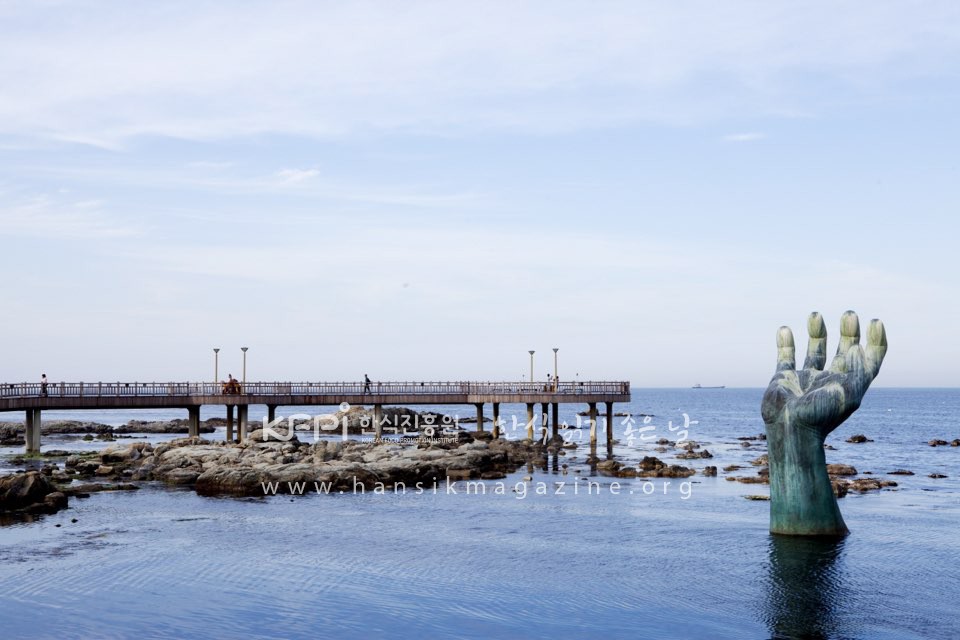
When the winter comes, the northwest monsoon and the cross wind blowing to Homigot create the turbulent,
and the trees in the mountain around Homigot reducing the humidity of wind to help the production of gwamegi
ⓒ Daegu Trip Road
The gwamegi is also the most produced and most famous in Guryongpo within Pohang. Guryongpo is designated as special zone for gwamegi and everybody evaluates Guryongpo is the best production site of gwamegi even if they are not Pohang people. That's because Guryongpo is equipped with the optimized environmental condition for the production of gwamegi. People say that's because northwest monsoon and the cross wind blowing to Homigot create the turbulent, and the trees in the mountain around Homigot reducing the humidity of wind to help the production of gwamegi.
The surprising fact is that almost saury which is made into gwamegi are not domestic products. The sauries which is raw ingredients of gwamegi are secured from north pacific ocean. That's because they have better taste, bigger size and more fatty and more nutritious than domestic saury, making the product value higher.
Even around 1980s, only Pohang people know and eat the gwamegi but when they are commercialized as Guryongpo's speciality, many thing changes. These day, the sliced gwamegi which cut the saury in half vertically is more common but the whole gwamegi which dried whole fish used to common in the past. The whole gwamegi was made by weaving it with straw and hanging it in a well ventilated place, and the point is to hang the fish's stomach upside down. This is because the oil in the gut spreads into the flesh during drying, giving it a richer taste.
These days, the whole gwamegi can be seen even a little. There are mania who prefers the whole gwamegi to the sliced gwamegi. They say the inner flesh of whole gwamegi is fresher with soft texture because it should be peeled off before eating. However, it is not that easy to trim it, so it is considered the sliced gwamegi, which is easy to eat, is commercialized more commonly.
It becomes more nutritious than when it used to be saury
In terms of nutrition, gwamegi is said to be better than when eating as saury. That's because the water reduces, the protein increases during the process of production and the nucleic acid increases during aging process. The nucleic acid components are effective in brain function strengthening, skin aging prevention and eye sight protection.
The flesh of the gwamegi is rich in calcium and vitamin D, which helps to strengthen bones, and is also effective in the growth of children and prevention of osteoporosis in women. In addition, it is rich in iron and B vitamins, which is effective for preventing anemia. It is well known that fish such as saury are rich in omega-3 fatty acids. Omega-3 is beneficial to blood vessel health by lowering blood cholesterol and preventing myocardial infarction. It is said to be also good for hangover relief, which is good news for drinkers. It contains various vitamins and aspartic acid, so it is effective in relieving fatigue and protecting liver cells.
These nutrients are said to be more generated in the process of making gwamegi. The process of making a gwamegi consists of the process of freezing and thawing. It is easy to say repeating the process but during this process, countless changes occur within the gwamegi. There are some studies showing that wind and sunlight at the proper temperature should be accompanied to ensure the nutritious ingredients of gwamegi increase the most.
Let’s embrace the mouthful scent of winter sea
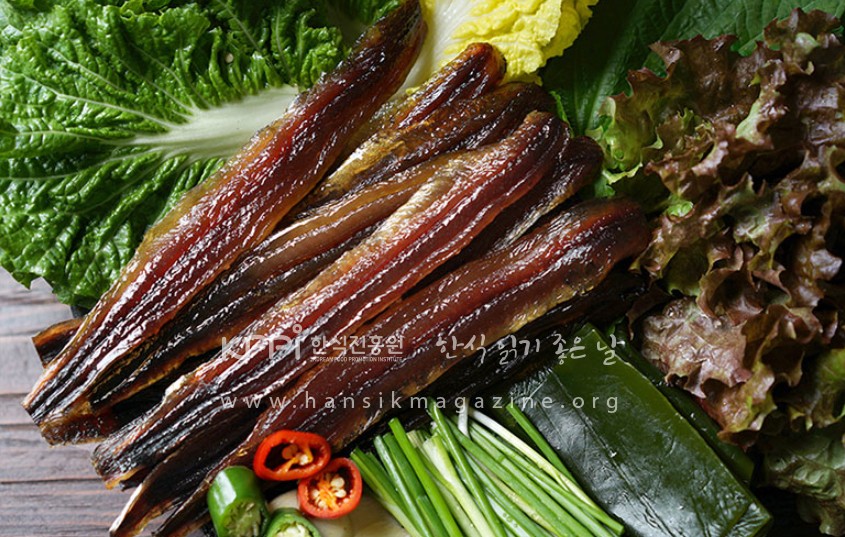
The taste of fresh wrapped seaweed and laver full of the scent of winter sea is excellent.ⓒ Pohang city hall
Even if it is a representative seasonal food in Pohang, like and dislike are divided even among Pohang people. Some people give up because of the fishy smell, while others shake their heads at the hard, sticky and chewy taste. In fact, many people avoid the oily gwamegi because the first impression is so strong. Nevertheless, those who enjoy gwamegi say that if you put it in your mouth and chew it for a long time, you will be addicted by the chewy and savory taste. The saying that even if there are people who can't eat, but no one eats only once, should be applied to gwamegi.
To enjoy gwamegi properly, you need side dishes accompanied. The main side dishes are raw seaweed and laver. Like gwamegi, raw seaweed and laver, which are in season in winter, relieve the first strong taste of gwamegi, and help those who try it for the first time feel the taste of gwamegi. Dip a bite-sized gwamegi in red sour chili sauce and wrap it in raw seaweed to find out why people like gwamegi. Another way to recommend to beginners is to wrap and eat it. If you order gwamegi in Pohang, you will be served with ssam vegetables such as cabbage, lettuce, and perilla leaves, and ingredients such as fresh green onion, fresh garlic, and cheongyang pepper as well as fresh seaweed and dried laver. Pick one of the ssam vegetables you want, add fresh seaweed or dried laver, add fresh green onions, fresh garlic, and cheongyang pepper, and put even a piece of gwamegi dipped in the sour chilly sauce on top and eat a bite. The fresh vegetables are crunchy, and the scent of the sea lingers in your mouth, followed by the chewy texture of gwameig. After swallowing all the wraps in your mouth, the aromatic flavor will leave an aftertaste. The gwamegi taste of eating like this is better than pork belly Koreans like.
However, even if the taste of gwamegi is felt, overeating gwamegi can cause sickness. People in Pohang describe a case of getting sick from overeating gwamegi as 'get adari'. It means a stomachache that makes you have no choice but to go in and out of the bathroom the day after you eat gwamegi. In response, Pohang people only guess that it might be because they ate a lot of oil-rich gwamegi, but have never heard of the exact reason. However, when it comes to solutions, Pohang people's wisdom(?) in their lives shows, and it means that if you drink soju with it, you won't get sick of it. Some people who don't drink alcohol say they don't get adari if they eat it with raw sweet potatoes. It's not exactly a proven story, but I've never seen people who usually eat gwamegi as a side dish get adari.
In order to enjoy the gwamegi, it is also important to choose a high quality gwamegi. A solid gwamegi which is not mushy without too much oil is good. A well-dried gwamegi has a reddish color on its inner flesh and has little fishy smell. Too yellow or black thing is not a good gwamegi. On the other side, the peeled back should have a shiny silver color. The fresher it is, the more shiny it is, which can be checked with your eyes.
However, it is regrettable that it is difficult to eat gwamegi after preservation. The leftover gwamegi should be eaten within one to two days, otherwise, it should be kept frozen. The well-greased gwamegi is said to be ready to eat if you take it out for a while and defrost it naturally because it doesn’t freeze completely in the house refrigerator, but it's not that easy. Failure in defrosting process may make the flesh mushy and the fishy smell stronger. So once frozen gwamegi is good to eat after cooking, such as roasting.
Gwamegi is still in the process of transformation.
As winter approaches, Pohang's gwamegi restaurants become busy. This is because more locals are seeking a gwamegi as a restaurant menu, and packaging and parcels orders are rushed. As such, during the gwamegi season, you can easily taste gwamegi at any Pohang restaurant. Among them, there are certain places that are particularly popular. Usually, they make an effort differentiated from other places.
The No.1 propaganda establishment designated by Pohang City to promote gwamegi, "gwamegi special zone Iho Restaurant" offers a variety of new menus, including fried gwamegi and gwamegi sushi, rather than the gwamegi that we used to see. Lee Seungyeon, owner of gwamegi special zone Iho Restaurant says "gwamegi is a nutritious food that everybody can enjoy if they check their freshness well, but it used to be a pity that there are people who can't even eat it," said. If you make a variety of recipes using the characteristics of gwamegi, which can be transformed into stews, braised and fries, children can eat it and the elderly can also enjoy it with the soft texture.
'Darakbang', which has operated a restaurant specializing in gwamegi every winter season since 1981, is known as a place where you can taste gwamegi dried on bamboo blind. If the gwamegi is dried on a bamboo blind, it retains the oil and tastes better. It is a work that requires more hands when dried on bamboo blind, but it is said that gwamegi are supplied through deokjang, which handles gwamegi dried with bamboo blind every winter.
As there are places that gwamegi in such a variety of ways, the constant change of gwamegi is good news for consumers who want to enjoy a variety of flavors.
Now, gwamegi season starts soon.
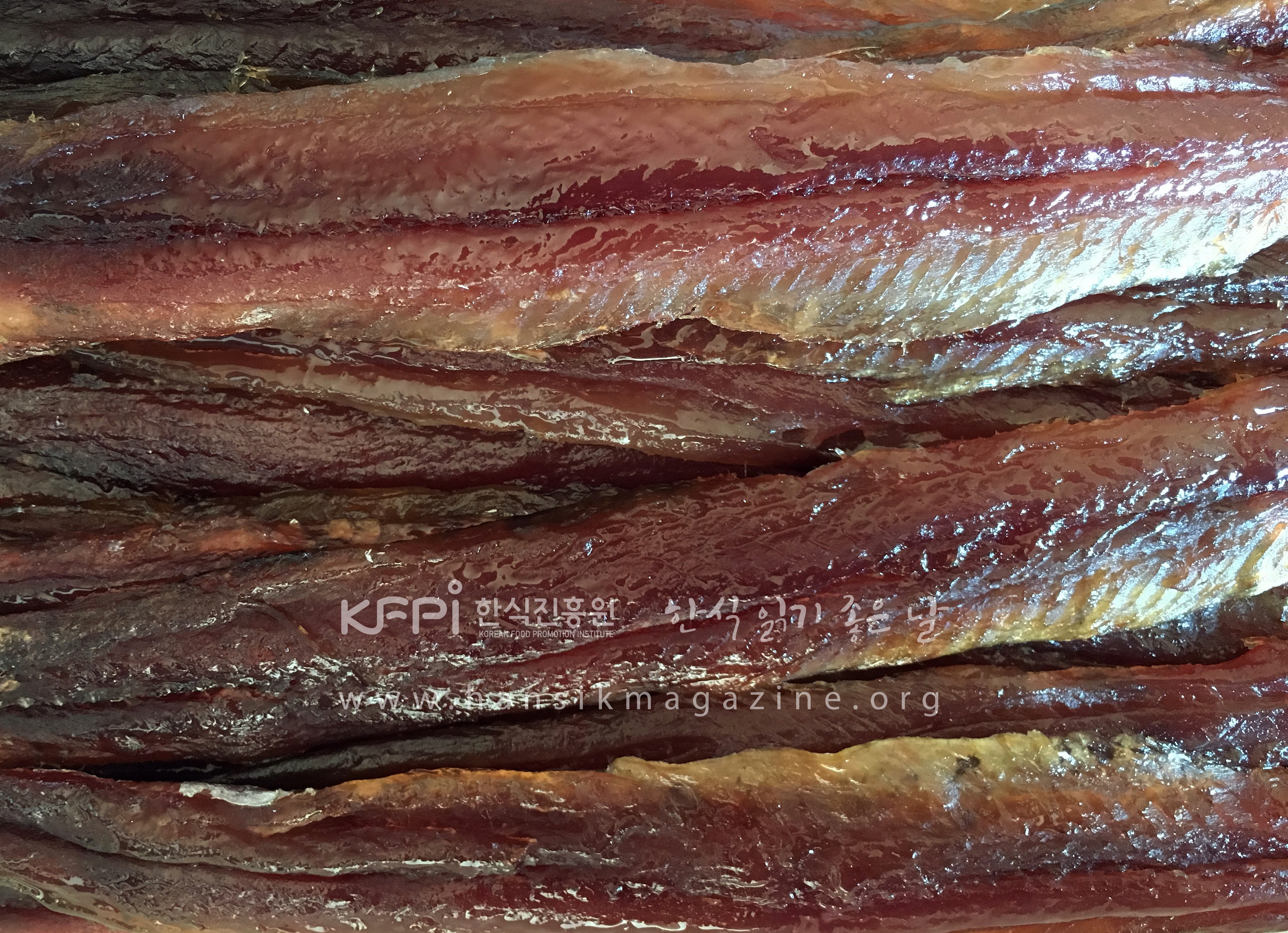
Gwamegi ⓒ Aenda Inc.
Now is the time when the gwamegi should have been in full swing in Guryongpo. However, because the deep sea fishing vessels catching saury in north pacific ocean didn’t return yet, the work has been delayed this year. The work usually begins from the mid of October, and the gwamegi is tasted in November, but it is said that the work can’t be processed because the saury is not warehoused until now around October 20.
However, when saury begin to enter Guryongpo, Pohang soon, you will see saury becoming a gwamegi dripping oil from the numerous deokjangs of Guryongpo. You don't have to visit Pohang to taste it. A single phone call will give you a taste of Guryongpo gwamegi. The gwamegi sent directly from Pohang is packed with raw seaweed, laver and various vegetables needed for ssam, so there is no need for trouble in preparing other ingredients. These days, when Covid-19 makes it difficult to travel for food, the modernization of gwamegi, which can be tasted by courier, is more pleasant.
Nevertheless, the most delicious way to eat gwamegi would be to visit the area of Guryongpo. After facing the cold sea breeze, when you enter the warm indoor to be served with a set of gwamegi with fresh seaweed, ssam vegetable, your mouth is watering. The seasonal food is tastier when encountered with the atmosphere of the site. We expect the day when we can face gwamegi myself in Pohang. Like a heart that misses gwamegi when the cold wind blows every year.
Edited by Noh Gyuyeop Published by Korean Food Promotion Institute
Noh Gyuyeop
Former leader of news team of <mountain> monthly magazine, he has served former chief editor of <Travel sketch>. Now acts as a travel writer.

 한국어
한국어
 English
English






